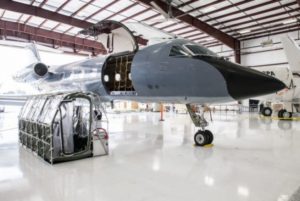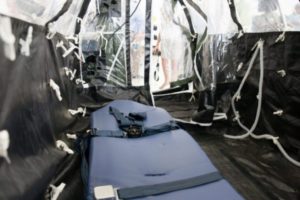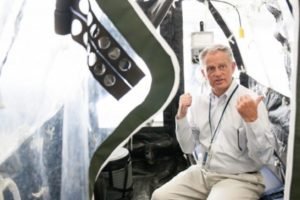The whole world relies on this one U.S. company to fly Ebola patients
By Josh Hicks October 28
Washington Post
When it comes to transporting Ebola victims by air, the world relies on just one small U.S. company.
Phoenix Air, a jet-charter service based in Cartersville, Ga., has flown 15 infected patients, including Europeans who worked in West Africa and five individuals who were treated in the United States — doctor Kent Brantly, photojournalist Ashoka Mukpo, missionary Nancy Writebol, and nurses Nina Pham and Amber Vinson.
Now the Defense Department is stepping up. The Pentagon this week said it is developing portable isolation units for use on its military aircraft, as thousands of U.S. troops head to West Africa to help combat the outbreak. The modules are expected to be tested next month and deployed in C-17 and C-130 transport planes by January.
Phoenix Air has been using the isolation system below this aircraft to transport Ebola patients. (EPA/BRANDEN CAMP)
“This system is being developed out of an abundance of caution, to reassure our service members working in Ebola-affected areas,” said Pentagon spokeswoman Jennifer Elzea. “There are no plans for DOD personnel to provide direct patient care, and therefore the exposure risk remains low” for troops, Elzea said.
The Obama administration has not decided whether it will use the isolation systems to transport non-military patients.
“This particular capability remains under development, so it would be premature to speak to its potential use,” said White House spokesman Ned Price.
One thing is for sure: The military transports would have greater capacity. Phoenix Air can fly only one infected individual at a time, whereas the military’s isolation units will hold up to 12 patients.
The Pentagon declined to share information about the development costs for the transport modules, saying the contract has not been finalized.
The tent-like isolation chambers mainly consist of a metal frame, a plastic liner and an air-filtration system. For the Phoenix Air flights, one doctor and two nurses attend to each patient.
A view of inside an Airborne Biological Containment System (ABCS) in Cartersville, Ga. (EPA/BRANDEN CAMP)
After each patient is transported, the company sprays toxic disinfectant inside the module for 24 hours and sends the contents — including the plastic, the stretchers and even the walkie talkies — off for incineration by a federally licensed hazardous-materials disposal team.
Phoenix Air created three isolation units in 2011 with help from the Centers for Disease Control and Prevention and the Defense Department. Those agencies provided scientific expertise and advice on how to manufacture special materials, respectively.
At the time, the CDC wanted a way to return infected medical workers to the United States instead of treating them in the field, because of growing concern about international conflicts, said Dent Thompson, the company’s vice president of operations.
The transport systems were finished in late-2011, but the outbreaks had long since died down. The units were placed in storage.
“We would periodically make various federal agencies aware that it existed and said, ‘If you ever need it, we can use it,’” Thompson said.
A call finally came from the State Department’s chief of emergency medicine in late-July, amid growing concerns about the West African Ebola outbreak. Phoenix Air quickly assembled a volunteer flight and medical crew after government officials inspected the system and gave it a thumbs-up.
“Within 48 hours, we were on our way to get the first patient,” Thompson said, speaking of the flight to transport Brantly on Aug. 2. The plane took Brantly to Atlanta and turned around almost immediately to fetch Writebol.
Vance Ferebee, flight nurse for Phoenix Air, sits inside a containment system in Cartersville, Ga. (EPA/BRANDEN CAMP)
Both trips, which cost about $200,000 each, including the decontamination process, were paid for by Samaritan’s Purse, a Christian humanitarian organization that the patients worked with in Liberia.
After those missions, Phoenix Air decided that the U.S. government should manage future transport efforts, because of the “real-world complexities of what it takes to make a mission like this work,” Thompson said. The challenges include dealing with U.S. customs officials, gaining permission to use foreign airspace and deciding which medical centers should treat the Ebola victims.
The State Department has since coordinated all flights, including those for foreigners returning to their countries. U.S. taxpayers pick up the tab for American patients, but the government requires reimbursement for the others.
“To me, this is no different from a soldier being shot in Afghanistan,” Thompson said. “The U.S. government is going to get that soldier and bring him home and put him in a medical facility.”
The federal government has been a longtime customer of Phoenix Air. In addition to flying executive charters and providing air-ambulance services, the business of about 225 employees also runs cargo for the military, provides flights for the U.S. Marshals Service and carried the White House’s presidential delegation to the 2014 Winter Olympics in Sochi, Russia.
The company now keeps one plane on standby for transporting Ebola victims.
“We’re like a firetruck in a fire station,” Thompson said. “We’re ready to go.”




